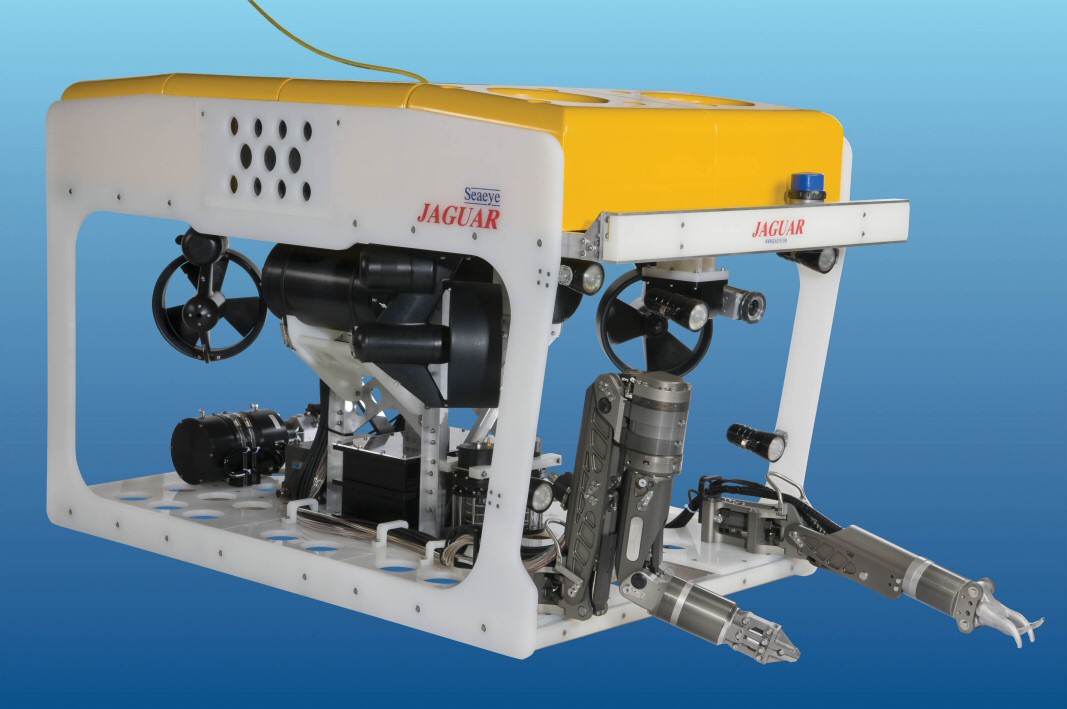It will bring significant cost savings in ROV operations by accelerating the shift from hydraulic to electric work ROVs for many more applications.
Revolutionary developments introduced in Saab Seaeye’s Jaguar ROV will further advance the company’s lead position as the world’s top electric ROV manufacturer.
At the core of the system is a completely new concept in control and power distribution that offers three key operational benefits:
Total dual-redundancy with self-diagnostics
Easy to configure and re-configure
Simple to pilot and operate
The fear of catastrophic system failure has been overcome through the Jaguar’s unique dual-redundancy system that is designed to keep the ROV on task long after other ROVs have stopped working.
With identical twin independent circuits installed, if one half completely shuts down, the vehicle remains operational and able to complete vital tasks. Failed system switchover is completely automated and happens in seconds.
This frees the ROV pilot to focus on the task in hand, rather than battling with diagnostic issues.

The Saab Seaeye Jaguar.
The new simplified intelligent system, with its fewer and more intuitive controls, makes it quicker to train new pilots and convert experienced pilots.
It also gives pilots more feedback in a more comprehensible form on every part of the ROV’s operation for a continuing and vital understanding of its performance.
Feedback on thruster performance for instance, is usually limited to just speed. Now the pilots also get reports on temperature, current and voltage.
Attempts by other companies to enhance system reporting have ended up with a higher component count and a consequential risk of more failures. Saab Seaeye on the other hand has cleverly improved feedback without increasing piece parts.
The simplicity of the Jaguar’s intelligent architecture minimises the time needed to mobilise and de-mobilise the vehicle.
It also makes it easy to interface a host of equipment including industry standard tools and sensors, thereby expanding the range of tasks possible.
For operators facing work in adverse conditions, the Jaguar has an unrivalled agility and responsiveness in strong cross currents, helped by a power-to-weight ratio that is best in its class.
And with an operational depth of 3000msw, with options up to 6000msw, and increased thruster power for faster descent and ascent, most subsea applications are within its range.
Behind the Jaguar developments is Saab Seaeye’s success in a work-ROV market previously dominated by hydraulic vehicles. Operators are turning to the powerful electric work ROV as they find it can complete 90 percent of tasks usually undertaken by an hydraulic vehicle, yet at far less cost, is easier to handle, quicker to mobilise and needs half the deck space.
The electric work ROV is not only suitable for the vast majority of work tasks, but is ideally suited for procedures such as drill support, survey operations, cable laying support, touch-down monitoring, IRM, and a high proportion of intervention and construction tasks.
Saab Seaeye is the world’s largest manufacturer of electrically operated ROVs, and its parent company, Saab Underwater Systems, is a world leader in sensor systems, precision engagement systems, and remotely operated and autonomous underwater vehicles.